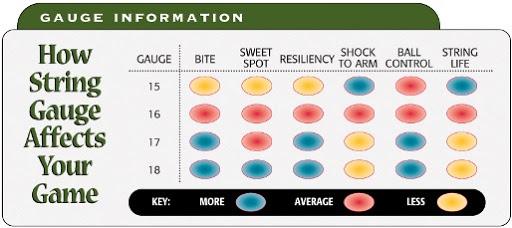How tennis string gauge affects spin, power and durability
First things first, tennis string gauge (thickness) DOES affect the spin and power of your shots, and also the durability of the strings!
Most recreational and club players have never paid any attention to the gauge (also referred to as thickness) of the string used in their racket… but you should!
The string you use in your racket is as important as the racket itself. Knowing the best gauge for you will not only improve your game and give you an advantage, but it will also save you money.
Why does gauge matter?
- Thinner strings are more elastic and therefore generate more spin and power
- Thinner strings are less durable and more prone to snapping
Spin and Power
Spin and power come from the elastic snap of strings on impact. You may have heard your coach or stringer use the trampoline effect analogy to explain this i.e. how deep a tennis ball goes into the racket on impact before flying away.
The greater the elastic snap on impact, the more power and spin generated if all other factors (tension, weight of racket, swing speed, conditions etc) remain the same.
How does the thickness of the string affect this?
Well, thinner strings are more elastic and therefore stretch more on impact creating a greater elastic snap effect.
Imagine tying a piece of rope between two buildings and walking on it, then doing the same thing again but this time with a much thicker rope. It’s pretty easy to imagine the rope that will bend more. The same physics apply to tennis strings.

Durability
Unfortunately, spin and power come at the cost of durability, and this is why it’s important to get the balance right… unless of course you have Roger Federer’s budget.
As explained above, thinner strings stretch more. Thus, they are more prone to snapping. There’s no getting around the fact that the thinner the string, the more prone it is to snapping when placed under the same amount of stress.
This is why you would more commonly see the word ‘durability’ advertised on packaging of thicker strings.
Our Recommendation
The overall recommendation here would be to use the thinnest tennis string gauge you possibly can that does not snap to give you a boost in spin and power.
Knowing the thinnest string that can handle and suit your style and power will ultimately come down to trial and error.
The general advice for club players that play regularly is to restring their racket every 2/3 months.
You could use this timeline as a benchmark to see how your strings are holding up. If the strings in your racket are looking untouched after 2/3 months of use, then it’s probably a good shout to opt for thinner strings next time you’re online or at your local tennis shop to get your racket restrung.


